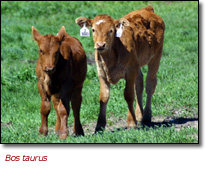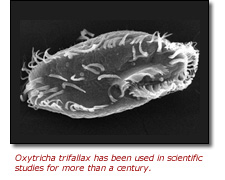Last updated: July 31, 2012
NHGRI Adds Cow and Dog To High Priority List For Sequencing Model Organisms

NHGRI Adds Cow and Dog To High Priority List For Sequencing Model Organisms
 BETHESDA, Md., Sept. 11, 2002 - The National Advisory Council for Human Genome Research has recommended adding the cow, the dog and the ciliate Oxytricha to the high-priority list of model organisms that should be considered for genome sequencing as capacity becomes available. Cow and dog join a growing group of high priority animals that includes chimpanzee, chicken and honeybee. Sequencing projects on the human, mouse and rat genomes are progressing rapidly, making sequencing capability supported by the National Human Genome Research Institute (NHGRI) available soon for work on other organisms.
BETHESDA, Md., Sept. 11, 2002 - The National Advisory Council for Human Genome Research has recommended adding the cow, the dog and the ciliate Oxytricha to the high-priority list of model organisms that should be considered for genome sequencing as capacity becomes available. Cow and dog join a growing group of high priority animals that includes chimpanzee, chicken and honeybee. Sequencing projects on the human, mouse and rat genomes are progressing rapidly, making sequencing capability supported by the National Human Genome Research Institute (NHGRI) available soon for work on other organisms.
"The priority list is based on medical and biological opportunities," said NHGRI Director Francis S. Collins, M.D., Ph.D. "But it is not yet a commitment to sequence the genomes of these organisms."
Sequencing the cow, along with the honeybee and the chicken, is expected to speed up studies of these agriculturally important animals. The proposal to sequence the cow was submitted by researchers at Baylor College of Medicine, the U.S. Department of Agriculture's U.S. Meat Animal Research Center, the University of Illinois and Texas A&M University.
"I am delighted that NIH has decided to give high priority to sequencing the bovine genome," said Joseph Jen, Under Secretary, Research, Education, and Economics, U.S. Department of Agriculture. "Sequencing the bovine genes will help in the development of meat and dairy products that consumers want while maintaining and increasing the safety of our food supply. USDA looks forward to participating in the research."
The proposal to sequence the dog was submitted by researchers at the Fred Hutchinson Cancer Research Center in Seattle, Wash., the Whitehead/MIT Center for Genome Research, Cambridge, Mass., and the Canine Genome Mapping Community, including researchers from a wide range of universities and institutions. The dog genome is expected to have medical benefits since dogs suffer many of the same diseases as humans. The dog is also an important model for the genetics of behavior and is used extensively in pharmaceutical research.
 In addition to dog and cow, council upgraded the priority of Oxytricha trifallax, a ciliated protozoan that has been used in scientific studies for more than a century, from moderate to high priority. The proposal to sequence the free-living, single-celled organism came from a team of researchers at the University of Utah, Princeton University and the Utah Genome Center at the University of Utah. The unique organism has a macronucleus containing a large number of chromosomes that appear to carry only one gene, or a small number of genes, and, presumably, its regulatory regions of DNA.
In addition to dog and cow, council upgraded the priority of Oxytricha trifallax, a ciliated protozoan that has been used in scientific studies for more than a century, from moderate to high priority. The proposal to sequence the free-living, single-celled organism came from a team of researchers at the University of Utah, Princeton University and the Utah Genome Center at the University of Utah. The unique organism has a macronucleus containing a large number of chromosomes that appear to carry only one gene, or a small number of genes, and, presumably, its regulatory regions of DNA.
Finally, council agreed with GRASPP to assigned moderate priority to Trichoplax, a primitive single-celled organism with a relatively small genome of 50 megabases or less. Researchers at Yale University, Oxford University and Baylor College of Medicine had proposed the organism.
NHGRI created a priority-setting process in 2001 to make rational decisions about the many requests being brought forward by various communities of scientists, each championing the animals used in its own research. Having the genome sequence of a model organism helps profoundly in the study of the biology of that animal. Comparisons with other genomes also help interpret the human reference sequence.
The institute uses the priority list to determine which genomes will enter the sequencing pipeline at the three large-scale sequencing facilities NHGRI currently supports. The priority-setting process does not result in new grants for sequencing the organisms. The three funded centers are: The Whitehead Institute/MIT Center for Genome Research in Cambridge, Mass.; the Genome Sequencing Center at Washington University School of Medicine in St. Louis, Mo.; and the Human Genome Sequencing Center at Baylor College of Medicine in Houston, Tex.
To nominate an organism, NHGRI asks scientists to write a white paper that justifies the substantial investment of acquiring an animal's genome sequence. White papers can be submitted three times a year, with deadlines on February 10, June 10 and October 10.
The white papers are reviewed by the Genome Resources and Sequencing Priority Panel (GRASPP), a blue-ribbon group NHGRI established to help set priorities. Evaluation criteria include an assessment of the medical importance of the proposed project; its importance to basic biological and evolutionary studies; the size of the research community interested in the DNA sequence; and the availability of additional research tools that would allow investigators to take maximal advantage of the new genomic sequence data.
"The priority is always subject to re-evaluation and is not a permanent designation or a commitment to begin sequencing," said William M. Gelbart, Ph.D., from Harvard University, a member of institute's advisory council and chairman of the GRASPP. "Our charge is to triage the many requests the NHGRI receives."
The panel recommends a ranking of high, moderate or low priority, and does not provide more fine-grained rankings within each category. NHGRI's advisory council agrees or disagrees with the ranking.
But even achieving high priority does not mean a center will automatically begin sequencing the organism. Capacity must first become available, and then NHGRI staff, assisted by its Sequencing Advisory Panel and sequencing center staff, must agree on the resources to expend on each organism.
Following these steps, the Washington University genome center was recently granted permission to begin work on the chicken genome; The Whitehead Institute/MIT center will begin work on several species of fungi of biomedical importance; and the Washington University and Whitehead centers will together begin work on the chimpanzee, in collaboration with colleagues in Germany and Asia. Baylor will begin work soon on the honeybee and the sea urchin genomes. Baylor also will devote capacity to sequencing the Drosophila pseudoobscura genome approved through another process.
The National Advisory Council for Human Genome Research is a federally chartered committee that establishes program priorities and goals for the institute and also provides second-level review of grant applications for NHGRI's extramural program. It meets three times a year, in February, May and September
Background on the advisory council
Contact:
Geoff Spencer
NHGRI
Phone: (301) 402-0911
